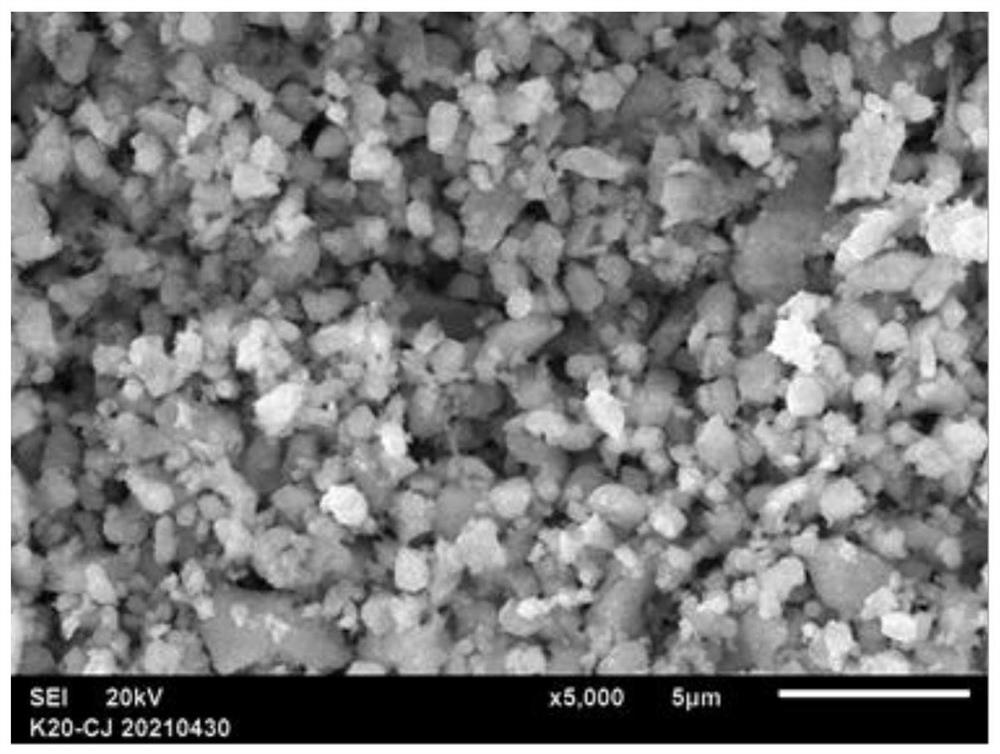Intermediate low-loss low-temperature co-fired ceramic material and preparation method thereof
A low-temperature co-firing and glass-ceramic technology, applied in the field of low-temperature co-firing ceramic materials, can solve the problems of restricted use and high sintering temperature
- Summary
- Abstract
- Description
- Claims
- Application Information
AI Technical Summary
Problems solved by technology
Method used
Image
Examples
Embodiment 1
[0055] Ba in this example 2 Ti 9 o 20 Based on the low-temperature co-fired ceramic material, based on the total amount of raw materials for its preparation, it includes the following components in mass content:
[0056] Ba2Ti9O20 55wt%;
[0057] Mg2SiO4 20wt%;
[0058] Low melting point glass powder 25wt%;
[0059] Wherein, the low-melting point glass powder includes the following components by weight:
[0060]
[0061] Ba in this example 2 Ti 9 o 20 A method for preparing a low-temperature co-fired ceramic material comprising the steps of:
[0062] (1) According to the selected mass content ratio, weigh the corresponding weight of BaTiO 3 、TiO 2 , add water (material: water=1:1.2) and ammonium acrylate dispersant (accounting for 0.7wt% of the powder amount) and mix evenly, use a ball mill to pre-mix for 3h, and then use a horizontal sand mill (the grinding medium adopts 0.65 mm zirconium balls) to disperse to obtain a uniformly dispersed slurry;
[0063] (2) U...
Embodiment 2
[0073] Ba in this example 2 Ti 9 o 20 Based on the low-temperature co-fired ceramic material, based on the total amount of raw materials for its preparation, it includes the following components in mass content:
[0074] Ba2Ti9O20 60wt%;
[0075] Mg2SiO4 15wt%;
[0076] Low melting point glass powder 25wt%;
[0077] Wherein, the low-melting point glass powder includes the following components by weight:
[0078]
[0079] Ba in this example 2 Ti 9 o 20 A method for preparing a low-temperature co-fired ceramic material comprising the steps of:
[0080] (1) According to the selected mass content ratio, weigh the corresponding weight of BaTiO 3 、TiO 2 , add water (material: water=1:1.1) and ammonium acrylate dispersant (accounting for 0.5wt% of the powder amount) and mix evenly, use a ball mill to pre-mix for 3h, and then use a horizontal sand mill (the grinding medium adopts 0.65 mm zirconium balls) to disperse to obtain a uniformly dispersed slurry;
[0081] (2) U...
Embodiment 3
[0090] Ba in this example 2 Ti 9 o 20 Based on the low-temperature co-fired ceramic material, based on the total amount of raw materials for its preparation, it includes the following components in mass content:
[0091] Ba2Ti9O20 65wt%;
[0092] Mg2SiO4 20wt%;
[0093] Low melting point glass powder 15wt%;
[0094] Wherein, the low-melting point glass powder includes the following components by weight:
[0095]
[0096] Ba in this example 2 Ti 9 o 20 A method for preparing a low-temperature co-fired ceramic material comprising the steps of:
[0097] (1) According to the selected mass content ratio, weigh the corresponding weight of BaTiO 3 、TiO 2 , add water (material: water=1:1.3) and ammonium acrylate dispersant (accounting for 0.8wt% of the powder amount) and mix evenly, use a ball mill to pre-mix for 3h, and then use a horizontal sand mill (the grinding medium adopts 0.65 mm zirconium balls) to disperse to obtain a uniformly dispersed slurry;
[0098] (2) U...
PUM
| Property | Measurement | Unit |
|---|---|---|
| specific surface area | aaaaa | aaaaa |
| resonant frequency temperature coefficient | aaaaa | aaaaa |
| shrinkage | aaaaa | aaaaa |
Abstract
Description
Claims
Application Information
 Login to View More
Login to View More - Generate Ideas
- Intellectual Property
- Life Sciences
- Materials
- Tech Scout
- Unparalleled Data Quality
- Higher Quality Content
- 60% Fewer Hallucinations
Browse by: Latest US Patents, China's latest patents, Technical Efficacy Thesaurus, Application Domain, Technology Topic, Popular Technical Reports.
© 2025 PatSnap. All rights reserved.Legal|Privacy policy|Modern Slavery Act Transparency Statement|Sitemap|About US| Contact US: help@patsnap.com



